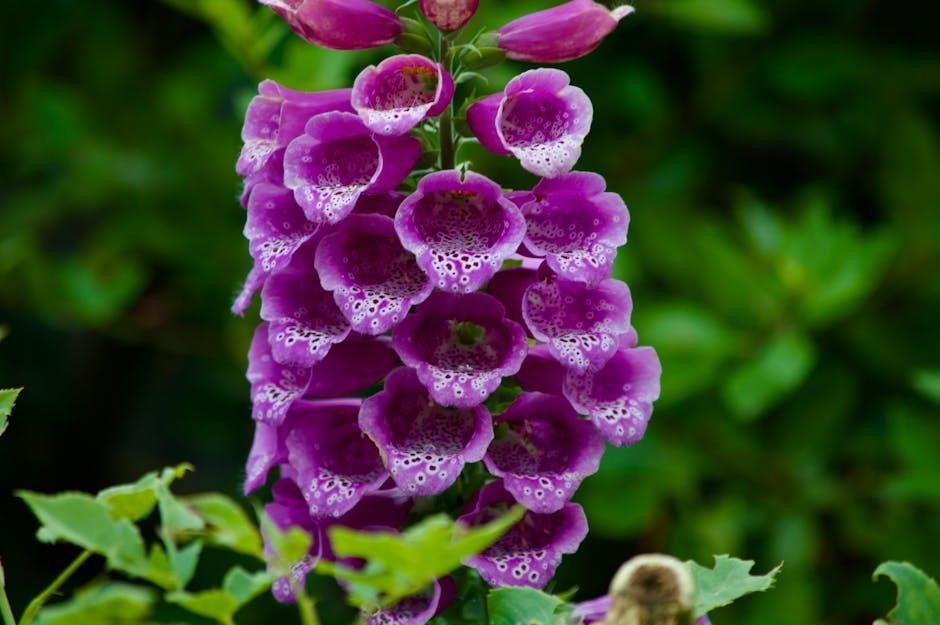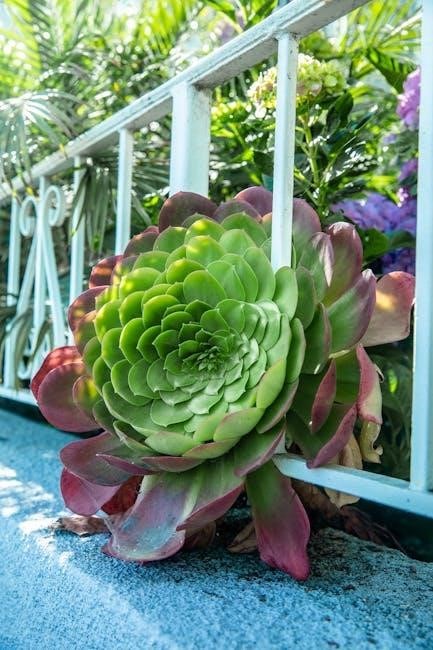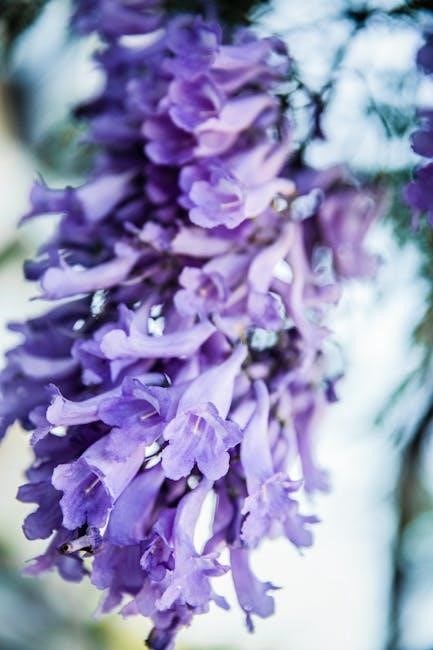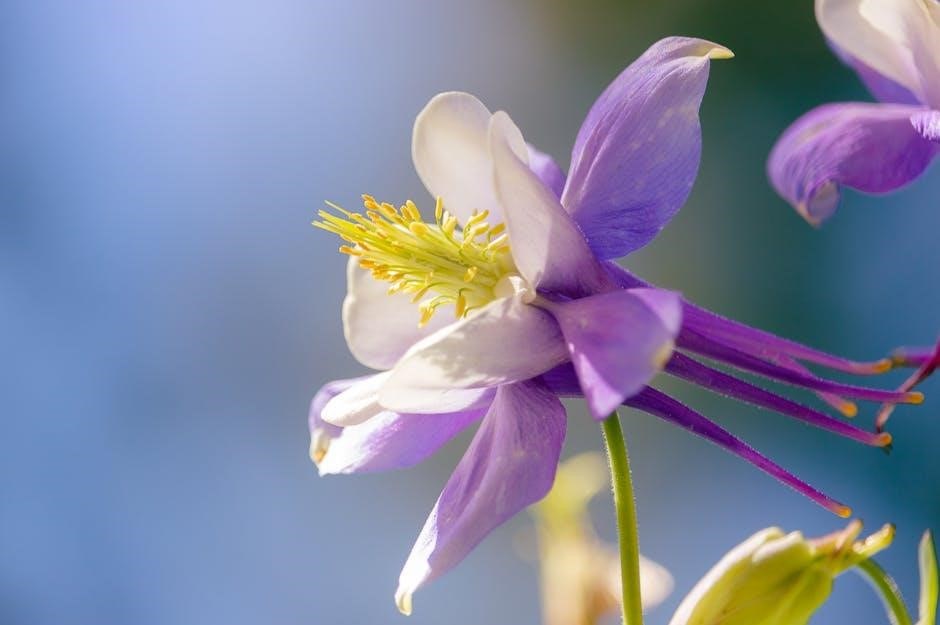California native gardening is a sustainable way to transform outdoor spaces, supporting local ecosystems and biodiversity. It offers unique challenges and rewards, tailored to the state’s climate and soil conditions.
Understanding California’s Climate and Soil
California’s diverse climate and soil conditions play a crucial role in native gardening success. The state’s Mediterranean climate, characterized by cool, wet winters and hot, dry summers, influences planting seasons and water needs. Native plants typically thrive when planted in fall or winter, as this aligns with their natural growth cycle. Soil types vary widely, from sandy coastal soils to clay-based inland soils, each requiring specific plant selections. Understanding your region’s climate zone and soil composition is essential for choosing plants that naturally adapt to these conditions. This alignment ensures healthier plants, reduced water use, and a more sustainable garden ecosystem.

Benefits of Native Plant Gardening
Native plant gardening offers numerous benefits, including enhanced biodiversity, water conservation, and low-maintenance landscapes. By choosing plants adapted to California’s climate, you support local pollinators and wildlife, creating a sustainable ecosystem. Native plants are inherently drought-tolerant, reducing the need for frequent watering and promoting water efficiency. They also require fewer pesticides and fertilizers, minimizing environmental impact. Additionally, native gardens often attract birds, butterflies, and beneficial insects, enriching the local flora and fauna. This approach not only fosters a connection to California’s natural heritage but also creates a resilient and visually stunning outdoor space that thrives with minimal intervention.

Month-by-Month Gardening Tasks
California native gardening requires tailored care throughout the year. This guide provides seasonal advice, ensuring plants thrive in each month’s unique conditions, promoting sustainability and adaptation.
Winter Months (December to February)
The winter months mark the beginning of the growing season for many California native plants. This is an ideal time for planting, as cooler temperatures and rainfall mimic natural conditions. Focus on supplemental watering to simulate winter rains, especially for newly planted species. Prune dormant plants to maintain shape and health, and apply mulch to retain soil moisture and suppress weeds. Check for pests like aphids and spider mites, which can thrive in milder winter days. Protect young plants from frost if necessary, and avoid overwatering to prevent root rot. These practices ensure your garden thrives during the wet season and prepares for spring growth.
Spring Months (March to May)
Spring is a vibrant season for California native gardens, with plants bursting into bloom. Watering needs increase as temperatures rise, but avoid overwatering to mimic natural dry-down cycles. Deadheading spent flowers encourages repeat blooming and maintains aesthetic appeal. Light pruning after flowering promotes healthy growth and shape. Fertilize sparingly, as natives thrive in poor soil. Monitor for pests like aphids and whiteflies, using natural controls when necessary. Weeds grow rapidly, so regular removal is essential. Mulch around plants to retain moisture and suppress weeds. This period is ideal for enjoying the colorful display of native wildflowers and ensuring your garden remains healthy and vibrant.
Plant Selection and Design
California native gardening involves selecting plants suited to your climate and soil type. Design considerations include spacing, color schemes, and companion planting for biodiversity and visual appeal.
Choosing the Right Native Plants for Your Garden

Selecting native plants tailored to your region’s climate and soil ensures thriving growth. Use resources like the Calfora database to identify species suited to your area. Assess your garden’s sunlight, water availability, and soil type to match plants to their natural habitats. Consider the desired aesthetic, such as vibrant blooms, foliage texture, or pollinator attraction. Incorporate plants that provide seasonal interest and support local wildlife. Consulting local nurseries can offer expert advice and region-specific plant recommendations, ensuring a successful and sustainable garden design.
Incorporating Companion Planting

Companion planting enhances growth and health by pairing plants that naturally benefit each other. California native plants often thrive when grouped with species they co-evolved with. For example, pairing nitrogen-fixing plants like lupines with wildflowers can improve soil fertility and promote vibrant blooms. Some natives, such as coyote mint, repel pests that might harm nearby plants. This method also supports pollinators by creating diverse habitats. Research or consult local experts to identify compatible species for your garden. Companion planting not only boosts biodiversity but also mimics the natural ecosystems of California, ensuring a balanced and resilient garden environment.
Water Management and Conservation
Efficient irrigation systems and rainwater harvesting are key to California native gardening. These practices conserve water while supporting plant health and sustainability in the state’s dry climate.
Efficient Irrigation Practices
Efficient irrigation is crucial for California native gardening, especially during dry months. Drip irrigation and soaker hoses deliver water directly to roots, minimizing evaporation and runoff. Smart irrigation controllers adjust watering schedules based on weather conditions, ensuring plants receive exactly what they need. Rainwater harvesting systems collect and store rain for non-potable uses, reducing water bills and reliance on municipal supplies. Mulching around plants retains soil moisture and regulates temperature. Avoid overwatering, as natives are adapted to drought. Water deeply but infrequently to encourage deep root growth. Regularly inspect irrigation systems for leaks or inefficiencies. Proper watering practices promote healthy growth and conserve this precious resource.
Harvesting and Conserving Rainwater
Harvesting and conserving rainwater is a vital practice for California native gardening, especially during the state’s dry seasons. Installing rain barrels or cisterns to collect runoff from rooftops is an effective way to store water for irrigation; Ensure systems are equipped with filters to remove debris and sediment. Use stored rainwater for watering plants, as it is naturally free of chemicals and minerals found in tap water. Distribute water directly to the roots to minimize evaporation. Consider seasonal patterns, as winter rains often replenish supplies, while summer months require careful conservation. Regular maintenance of rainwater systems ensures they remain functional and efficient year-round.

Garden Maintenance and Care
Regular watering, pruning, and mulching are essential for sustaining California native plants. Proper care ensures soil health and supports biodiversity, promoting a thriving, low-maintenance garden year-round.
Pruning and Mulching Techniques

Pruning and mulching are essential for maintaining California native plants. Prune during winter or early spring to promote healthy growth and remove dead or damaged branches. Light pruning encourages bushy shapes, while heavier cuts rejuvenate overgrown plants. Mulching retains soil moisture, suppresses weeds, and regulates temperature. Use organic mulch like bark chips or leaves, keeping it thin to avoid overheating the soil. Avoid mulching directly around plant stems to prevent rot. Regular mulching supports soil health and reduces the need for frequent watering. These practices ensure your native garden remains vibrant and resilient throughout the year, supporting local biodiversity and ecosystem balance.
Pest Management and Disease Control

Pest management and disease control are crucial for maintaining a thriving California native garden. Use integrated pest management (IPM) to minimize harm to beneficial insects. Encourage natural predators like ladybugs and lacewings by planting diverse natives. Companion planting can deter pests naturally, such as using native herbs to repel insects. Regularly inspect plants for signs of pests or disease and remove infested areas promptly. Apply organic solutions like neem oil or horticultural soap for severe infestations. Avoid overwatering, as it can lead to root rot and other diseases. Native plants are generally resilient, but vigilance and organic methods ensure their health and longevity, supporting biodiversity and ecosystem balance.
Celebrate your gardening achievements and explore local nurseries for native plants. Consult experts for personalized advice to enhance your garden’s sustainability and beauty.
Encouraging Biodiversity and Sustainability
California native gardening fosters biodiversity by creating habitats for local wildlife, pollinators, and beneficial insects. Native plants naturally attract bees, butterflies, and birds, supporting the local ecosystem. By choosing plants adapted to the region’s climate and soil, you reduce the need for pesticides and fertilizers, promoting sustainable practices. Companion planting enhances growth and pest resistance, while mulching retains moisture and suppresses weeds. These methods create a self-sustaining environment that thrives with minimal intervention. Native gardens also sequester carbon and conserve water, making them an eco-friendly choice. By embracing these practices, you contribute to a healthier planet while enjoying a vibrant, resilient garden.
Local Nurseries and Expert Consultations

Visiting local nurseries specializing in California native plants is an excellent way to discover species suited to your region. Experts at these nurseries can offer personalized advice, helping you choose plants that thrive in your specific climate and soil conditions. Many nurseries also provide workshops and resources on native gardening practices. Consulting with local experts ensures your garden is both sustainable and biodiverse. Additionally, resources like the Calfora database can help you identify native species and their growing conditions. Leveraging these local resources enhances your gardening success and supports environmentally friendly practices tailored to California’s unique ecosystems.



